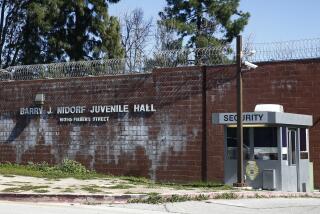New County Project Will Offer Ways Out for Teens in Trouble
- Share via
More young people are committing more serious crimes at a younger age, Orange County officials said Monday in announcing a new program to help trouble-prone teen-agers.
The program is called the Juvenile Connection Project. It will function essentially as a clearinghouse, linking youths with services designed to keep them out of trouble, according to Superior Court Judge Betty Lou Lamoreaux, presiding judge of Juvenile Court.
The services could include counseling, tattoo removal for youths wanting to erase that prominent form of gang identification, or dental work to help a youngster’s sense of self-esteem, said Michael A. Schumacher, the county’s chief probation officer.
The program, Schumacher said, will concentrate on youths younger than 15 and target an “at-risk” group with “one foot in trouble and the other on a banana peel.”
$25,000 Grant Received
“The ideal is to try to do something about that banana peel before things get any worse,” he said.
While Orange County has resources to help juveniles who could be headed for delinquency, there is no coordination of those services, Schumacher said, and many who need help do not know where to find it.
The California Youth Authority has given the county a $25,000 grant to start the program. Schumacher, Lamoreaux and Board of Supervisors Chairman Roger R. Stanton announced the project Monday at a press conference.
In addition, 300 business, education and civic leaders have been invited to a briefing on the program Thursday at the Ritz-Carlton Laguna Niguel, they said. Those invited will be asked to help the program by providing services or funds.
Needed are doctors to provide pre-employment medical examinations, clothiers to donate suits for job seekers and counselors who would advise youths at no charge.
Schumacher said the county pays $53 a month to supervise a juvenile on probation and $70 daily to house a youth at Juvenile Hall. The program is ultimately expected to save taxpayers money.
Among the speakers at Thursday’s briefing will be officials involved in the project in Los Angeles County, where it began about 1982, according to Barry Nidorf, chief probation officer for Los Angeles County.
‘Outstanding Program’
Nidorf said Monday that the Los Angeles County program started with a $25,000 grant from a private foundation. Fund-raisers and foundation grants provide the program with a budget of about $300,000 a year, he said, adding, “It’s an outstanding program.”
Nidorf said the county does not provide services itself, but instead evaluates children referred by parents, teachers, police or other agencies. Those children are then referred “to an appropriate resource in the community,” he said.
Resources range from “traditional counseling, drug, alcohol sort of things, (to) medical, dental, psychiatric, tattoo removal, learning disabilities,” Nidorf said. “Just name it.”
The Los Angeles program operates in the San Fernando Valley, handling about 100 youths referred each month by the courts, defense attorneys, probation officers and police. An even larger number of referrals come from parents, teachers or the youths themselves, Nidorf said.
In Orange County in 1985, Schumacher said, 18,000 people below the age of 18 were arrested. He said 10,000 of those were referred to the Probation Department, including 7,000 whose violations wereserious enough to land them in Juvenile Court. The remaining 8,000 were released without further involvement in the juvenile justice system.
Crime Rate Increasing
The county’s crime rate among juveniles is increasing 3% to 4% a year, Schumacher said, adding that in recent years Juvenile Hall has had periodic overcrowding as a result.
Also, “increasing numbers” of youngsters 12, 11 or even 10 years old are being arrested each year, with the severity of their crimes also increasing, Lamoreaux said.
In addition, more than two-thirds of the county’s juvenile delinquents are abusers of drugs or alcohol, Schumacher and Lamoreaux said.
Still, 70% of the youths brought into the juvenile justice system for the first time do avoid future trouble, Lamoreaux said, adding that she hoped the new program would help keep them out of the system entirely.
“We want to catch these kids” before they become statistics in the system, Schumacher said.
“As chief probation officer, I see a lot of kids who have dreams and have things that they would like to do in life,” Schumacher said.
“They can’t always do that. They can’t get their life in order. They can’t get themselves back on the straight and narrow.
“This is an opportunity to engage in a treatment program, in a prevention program, and one that is out in front of the system so that we don’t have to deal with them later on.”
More to Read
Sign up for Essential California
The most important California stories and recommendations in your inbox every morning.
You may occasionally receive promotional content from the Los Angeles Times.










